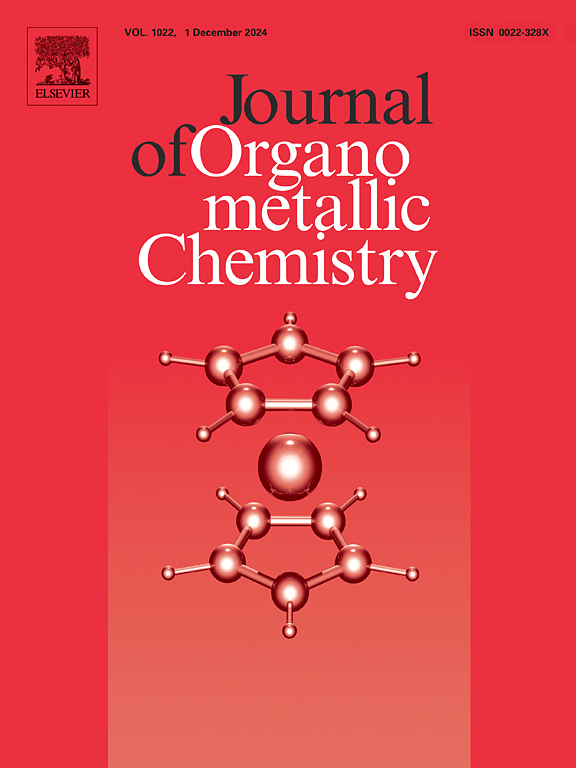Syntheses, structures, in vitro cytostatic activity and antifungal activity evaluation of six organotin(IV) complexes based on Quinoline-6-carboxylic acid
IF 2.1
3区 化学
Q3 CHEMISTRY, INORGANIC & NUCLEAR
引用次数: 0
Abstract
Six new organotin(IV) complexes, [R3Sn(C10H6NO2)(H2O)] (R = Me 1, R = Et 2, R = n-Bu 3, R = Ph 4), [(Me2Sn)4(µ3![]() O)2(C10H6NO2)4] (5), [(n-Bu2Sn)4(µ3
O)2(C10H6NO2)4] (5), [(n-Bu2Sn)4(µ3![]() O)2(C10H6NO2)4] (6) were synthesized through the reaction of R3SnCl (R = Me and Et), (R3Sn)2O (R = n-Bu and Ph) or R2SnO (R = Me and n-Bu) with 6-quinoline carboxylic acid, and characterized via elemental analysis, FT-IR, NMR (1H, 13C and 119Sn) and single crystal X-ray diffraction analysis. The structural analyses revealed that the centric Sn atoms display five-coordinated distorted trigonal bipyramidal geometry for complexes 1–4. Complex 5 and 6 exhibited tetranuclear tin ladder-like geometry. The in vitro cytostatic activities of complexes 1–4 were assessed against HepG-2, A549 and HeLa cell lines by MTT method. The results indicated that tributyltin derivative 3 and triphenyltin derivative 4 exhibited better potent cytostatic efficacy than triethyltin derivative 2. Moreover, the preliminary anticancer mechanism for tributyltin derivative 3 against HeLa cell lines was investigated. The experimental results revealed that complex 3 may trigger mitochondrial depolarization and generate excessive ROS, and then induce HeLa cell apoptosis. In addition, antifungal tests were conducted to assess the inhibitory effects of complexes 1–4 against three plant pathogenic fungi, which showed that complex 4 exhibited significant antifungal effects on Physalospora piricola. Furthermore, toxicity was evaluated using Pro Tox-II. And then, the ADME parameters, pharmacokinetic properties, and drug-likeness properties of the synthesized complexes were predicted by the Swiss ADME simulator.
O)2(C10H6NO2)4] (6) were synthesized through the reaction of R3SnCl (R = Me and Et), (R3Sn)2O (R = n-Bu and Ph) or R2SnO (R = Me and n-Bu) with 6-quinoline carboxylic acid, and characterized via elemental analysis, FT-IR, NMR (1H, 13C and 119Sn) and single crystal X-ray diffraction analysis. The structural analyses revealed that the centric Sn atoms display five-coordinated distorted trigonal bipyramidal geometry for complexes 1–4. Complex 5 and 6 exhibited tetranuclear tin ladder-like geometry. The in vitro cytostatic activities of complexes 1–4 were assessed against HepG-2, A549 and HeLa cell lines by MTT method. The results indicated that tributyltin derivative 3 and triphenyltin derivative 4 exhibited better potent cytostatic efficacy than triethyltin derivative 2. Moreover, the preliminary anticancer mechanism for tributyltin derivative 3 against HeLa cell lines was investigated. The experimental results revealed that complex 3 may trigger mitochondrial depolarization and generate excessive ROS, and then induce HeLa cell apoptosis. In addition, antifungal tests were conducted to assess the inhibitory effects of complexes 1–4 against three plant pathogenic fungi, which showed that complex 4 exhibited significant antifungal effects on Physalospora piricola. Furthermore, toxicity was evaluated using Pro Tox-II. And then, the ADME parameters, pharmacokinetic properties, and drug-likeness properties of the synthesized complexes were predicted by the Swiss ADME simulator.

六种喹啉-6-羧酸有机锡配合物的合成、结构、体外抑细胞活性及抗真菌活性评价
6个新的有机锡(IV)复合物,[R3Sn (C10H6NO2) (H2O)] (R = 1, R = 2, R = n-Bu 3, Ph值R = 4), [(Me2Sn) 4(µ3 o) 2 (C10H6NO2) 4) (5), [(n-Bu2Sn) 4(µ3 o) 2 (C10H6NO2) 4)(6)通过R3SnCl的反应合成了(R =我,等),(R3Sn) 2 o (R = n-Bu和Ph值)或R2SnO (R =我和n-Bu) 6-quinoline羧酸,并通过元素分析、ir、NMR (1 h、13 c和119 sn)和单晶x射线衍射分析。结构分析表明,配合物1 ~ 4的中心锡原子呈五配位畸变三角双锥体几何结构。配合物5和6呈现出四核锡阶梯状几何结构。采用MTT法测定复合物1 ~ 4对HepG-2、A549和HeLa细胞株的体外抑细胞活性。结果表明,三丁基锡衍生物3和三苯基锡衍生物4比三乙基锡衍生物2具有更强的细胞抑制作用。此外,还初步探讨了三丁基锡衍生物3对HeLa细胞株的抗癌作用机制。实验结果显示复合物3可能触发线粒体去极化,产生过多ROS,进而诱导HeLa细胞凋亡。此外,对配合物1 ~ 4对3种植物病原真菌的抑制作用进行了抑菌试验,结果表明,配合物4对梨状Physalospora piricola具有显著的抑菌作用。此外,使用Pro x- ii进行毒性评价。然后利用瑞士ADME模拟器预测合成配合物的ADME参数、药代动力学性质和药物相似性质。
本文章由计算机程序翻译,如有差异,请以英文原文为准。
求助全文
约1分钟内获得全文
求助全文
来源期刊

Journal of Organometallic Chemistry
化学-无机化学与核化学
CiteScore
4.40
自引率
8.70%
发文量
221
审稿时长
36 days
期刊介绍:
The Journal of Organometallic Chemistry targets original papers dealing with theoretical aspects, structural chemistry, synthesis, physical and chemical properties (including reaction mechanisms), and practical applications of organometallic compounds.
Organometallic compounds are defined as compounds that contain metal - carbon bonds. The term metal includes all alkali and alkaline earth metals, all transition metals and the lanthanides and actinides in the Periodic Table. Metalloids including the elements in Group 13 and the heavier members of the Groups 14 - 16 are also included. The term chemistry includes syntheses, characterizations and reaction chemistry of all such compounds. Research reports based on use of organometallic complexes in bioorganometallic chemistry, medicine, material sciences, homogeneous catalysis and energy conversion are also welcome.
The scope of the journal has been enlarged to encompass important research on organometallic complexes in bioorganometallic chemistry and material sciences, and of heavier main group elements in organometallic chemistry. The journal also publishes review articles, short communications and notes.
 求助内容:
求助内容: 应助结果提醒方式:
应助结果提醒方式:


